
rexresearch
rexresearch1
Theo
OLMO / Ricardo GIL
Fog Collector
Fog Collector
http://revolution-green.com/fog-catchers/
[ Excerpt ]
The
Fog Catchers
... Developed over the past 5 years on the Canary Islands by Hernando Theo Olmo and Ricardo Gil, the “Water Gardens” are groupings of water-extracting towers for high volume and high quality water. Some of the planned uses are for forests, camping, fire suppression, agriculture, livestock, and human consumption.
According to the website; After years of experimentation and improvement, our NRP 3.0 fog collectors are currently the most technically advanced and productive in the world in the last 50 years in this sector, with a maximum collection of 1,074 liters / day and a life of more than 10 years.
The NRP 3.0 fog collector, have a huge collecting surface of 56 m2 into minimum space, only 1.6 m2, thus reducing the area occupied by 90% and minimizing the visual impact. Its three-dimensional structure gives great stability and prevents the loss of water out of the structure and also minimizes the influence of the wind direction in production of water. It also has a base designed to decant and filter the water before it passes to the tube system.
The materials used give the NRP 3.0 high strength, low weight and high durability.
Due to the rate cost-production, this system allows us to consider definitely the mists as another water resource, complementary to the existing resources, and this, in a practical, cost-effective, sustainable and innovative. Water from the mist can be used for qualitative and quantitative improvement of the waters from another origin, which can also help to reduce transportation costs, pumping or treatment of these, saving energy and minimizing pollution.
The
World's First Water Farm !

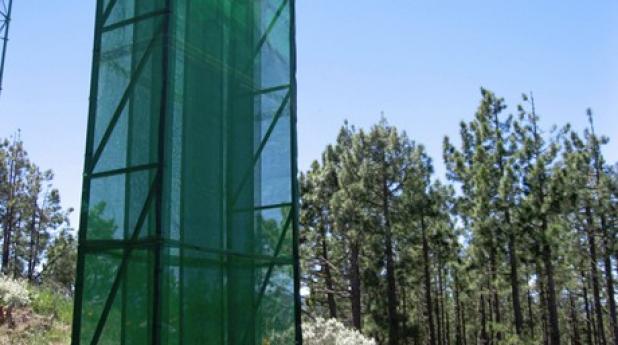
http://eng.aguadeniebla.com/index
Fog
Collectors NRP 3.0
The revolution in fog water collection
After years of experimentation and improvement, our NRP 3.0 fog collectors are currently the most technically advanced and productive in the world in the last 50 years in this sector, with a maximum collection of 1,074 liters / day and a life of more than 10 years.
The NRP 3.0 fog collector, have a huge collecting surface of 56 m2 into minimum space, only 1.6 m2, thus reducing the area occupied by 90% and minimizing the visual impact.
Its three-dimensional structure gives great stability and prevents the loss of water out of the structure and also minimizes the influence of the wind direction in production of water.
It also has a base designed to decant and filter the water before it passes to the tube system.
The materials used give the NRP 3.0 high strength, low weight and high durability.
Due to the rate cost-production, this system allows us to consider definitely the mists as another water resource, complementary to the existing resources, and this, in a practical, cost-effective, sustainable and innovative.
Water from the mist can be used for qualitative and quantitative improvement of the waters from another origin, which can also help to reduce transportation costs, pumping or treatment of these, saving energy and minimizing pollution.
Design Bases
Development of fog collectors NRP 3.0
As we have been working for some years in a scientific and in a professional way with the flat collectors or Chilean type, we realiced its complications and shortcomings. For this reason, in 2008 we began to design some collectors based on the following design bases:
A fog collector very stable against wind and with no need of tensioners, which occupies little space, easy to transport and to install, it does not need constant maintenance, it avoids constant loosing of water, (collected by the meshes) outside the structure, and therefore, the loss of production, which will increase the rate of precipitation of drops already captured, not been influenced by changes in the direction of the mist , so therefore, is is able to get more than 100 liters per day.
With all these data, we design our NRP 3.0 fog collectors in different models depending on their size, whose name refers to plants of the Canarian forest: Erica, Pinea and Garoé.
What is fog water collection?
The fog, produced normaly by low clouds impacting against a rugged terrain, can be captured by special mesh placed pn a support structure. These meshes retain the tiny water drops floating in the air, imitating the process made ??by the treetops and giving the name to the phenomenon known as "horizontal precipitation".
This technique is studied for over 50 years in many parts of the world and allows the use of this water resource.
It was in Chile, particularly in the Atacama Desert, where it began to research and develop collection instruments primarily between the years 1960-1980, with the help of distinguished researchers from the Catholic University of the North.
This is how the Chilean type "catchers" appeard, which have been used up to now. Although cheap and easy, these fog collectors have certain drawbacks such as low production, occupied area, water leaks out of the structure, stability problems and breakage.
In order to solve these problems, we have designed the NRP 3.0 fog collectors, which represent the most advanced technology and higher production worldwide today.
Girja
SHARAN : Dew Yield from Passive Condensers in a Coastal
Arid Area [ PDF ]
ES1068289 -- CAPTADOR
TRIDIMENSIONAL DE AGUA DE NIEBLAS, ROCIO Y PRECIPITACIONES
C ON SUPERPOSICION DE CAPAS INTERIORES
ABSTRACT
1. Shutter dimensional water mist, dew and rain with overlapping interior layers characterized by being configured by a three dimensional structure, prism-shaped, preferably coated insect screen (60% shade), whose base is preferably square and containing a series of vertical inner layers of mesh individualized scavenger and supported by cables, increasing the scavenging exposed surface without taking up space, which guarantees a water intercepted multiplication (with respect to planes equipment) and generating a turbulent wind maze charged drops passing through the structure.
2.
Water scavenger dimensional mist, dew and rain with overlapping inner layers according to claim 1, wherein the base of the three-dimensional structure has a box whose bottom is inclined for collecting and solids settling level of the water collected integrating well strainer at the start and a stopcock on one end for easy cleanup.
Also it includes in its outer corners of seat plates to allow anchoring the structure to any kind of surface.
3.
Water scavenger dimensional mist, dew and rain with overlapping interior layers, according to claims 1 and 2, characterized in that has a shoe designed to ensure the sensor ground anchor without the need for works, the easier and cheaper installation, reducing work times and minimizing the cost of materials.
the weight of the land is exploited, allowing turn the sensor location can be changed if so desired, still remains at the first settlement.
DESCRIPTION
Dimensional sensor water fog, dew and rain with overlapping inner layers.
Technical Field
Collection, settling and filtering water mists, dew and rain, forest, agricultural and livestock and human use.
BACKGROUND ART
Since ancient times man has taken advantage of alternative water resource that nature offered, such as using the mists captured by vegetation and rocks waters.
The best known case in the Canary Islands this type of exploitation is to Garoé Tree, a sacred tree in the Iron and that mentions the sixteenth century in which he recounted how their branches there flowed the precious liquid.
Another example is the use of water mist captured by branches of heather or woolen blankets (in the Chilean desert Atiquipa) plus vine crops Lanzarote, in holes dug into gravel (lapilli) (which holds the condensation overnight due to its porosity).
In the 60s a group of Chilean researchers (UCN) began investigating in capturing the Camanchacas water (sea fog), with such illustrious names as A. Acosta Baladon and C. Espinosa.
The latter obtained a patent (not 18,424) for a device for capturing water in mist or camanchacas.
The collected water ranged between 1.5 liters per day to a maximum of over 15 liters / day.
The annual average was 3.9 captured liters a day between 1961 and 1963).
In the late 80s and early 90s, the research group led by Canadian Schemenauer R. and P. Cereceda, continued to work in the same region of Chile (Proyecto El Tofo), jumping to fame by supplying meshes flat trunks supported by 5 meters high (equipment Stándar Fog Collector or SFC) to Chungungo populated fisherman, who had 440 permanent residents.
After that they continued implementing this technique, CFS 0.5 x 0.5 meters pickup surface worldwide (Namibia, Oman, Peru, etc.).
In the Canaries, researchers and L. Pérez Santana, began to perform experiments in the archipelago in the early 80s (1983-1985).
In the 90s, the professor of the Faculty of Geography, University of La Laguna, MV Marzol Jaen, began to implement the techniques of the Canadian group, with the use of SFC 0.5 x 0.5 meters, in Tenerife (Teno, Anaga, etc.).
In the late 90's and early 2000, a private investigator, C. Sánchez Recio recorded in Canarias (in 2000) planes sensors (such as Chile) but slant auxiliary trays (and other models tapered trunk which have not materialized).
These teams represent the only record as a utility model in Spain of equipment to capture fog water (reference U9901838).
Begins to realize, through his private company (Natural Aqua Canarias SL), projects the government majority for the implementation and use of these equipment (Aquair optimizer).
They consist of a vertical frame of 5 x 2 meters, supported by guy and concrete footings, with 7 trays placed inclined 50 deg in order to reduce the effects of wind on the grid central catch.
Water is collected in a gutter of PVC placed 1 m from the ground.
Total pickup area is 8 m2 vertically.
The sensor along with its tension, occupies 16 m2 of land and 5 m in height.
Due to its size usually they have breakage due to wind effects on the structure, along with a laborious task of transport, assembly, installation and maintenance.
He is having worked with both research groups Marzol Jaen (Geography ULL), the Hydrology Group ICIA (Canarian Institute of Agrarian Research) ETSIA the University of La Laguna, having had knowledge of Santana Perez (from 1998), momentum and deal with Baladon Acosta and others, like Alain Gioda (IRD French Institute of Research for Development) and the work done in Natural Aqua Canarias SL, with Sánchez Recio, for 3 years, Theo Hernando Olmo, inventor of the water trap of fog, dew and rainfall, wants to step forward both in the world of technology capture water from fog and dew, as in their application, implementation and dissemination to society.
Already submitted the application for the utility model 200800661, sensor with self-generated turbulence.
DESCRIPTION OF THE INVENTION
The gauge of water mists, dew and precipitation is a three dimensional structure, prism-shaped, with a square base of 0.7 m. side and 2 m in height, preferably. newpage
It consists of a metal base for anchoring the computer, the vertical support structures, decanting and filtering the collected water, upstanding structures formed by tubes 2 m. length, an upper part and a crown or inner layers of mesh supported by steel cables.
For the collation of the team on earth metal shoe that, being buried at 30 cm it is used. Depth can take advantage of the weight of the earth to support the team extracted without the need to pour concrete and the possibility of their removal and reuse without leaving residues on the ground.
The shoe has four floored rods at each end that fit the anchor pieces on the ends of the computer base.
For installation on concrete, just place about 4 wall plugs and screws 8 mm in the same anchoring parts.
This layering an exhibition of nearly 11 m2 of surface scavenging without taking up space on the ground (only 0.5 m2) is achieved.
Being cubic need not direct it toward a particular wind direction, but preferably its orientation towards the dominant wind direction at each location is recommended.
This prismatic structure peripherally coated with plastic insect screen (5.6 m2 in total) and internally by a second layer of metal mesh screened 1 m. high (covering three faces of the gauge, 2.1 m2 in total).
In the center of this structure (interior) are installed between 3-5 successive layers vertical mesh (as curtains) by creating an opposition in the path drops laden air passes through the sensor.
They are supported by frames made with steel cables that are attached to the base and the top or crown piece by small carabiners and rings.
The cables provide flexibility, stability and light weight.
Thus, increase harvest levels (greater exposed surface pickup) without taking up space and resisting conditions of moderate to strong wind.
The drops retained in the mesh aggregate to form larger diameter droplets that slide towards the base where the solids are retained possible present before departure by decantation.
Water leakage occurs by overflow, through a small strainer, preventing the floating materials such as plant debris or insects, pass the conduction system.
Because the inner layer is coated with metal insect screen and the structure of the sensor is also metal, night condensation of the circulating air, dew (clear skies at night hours), as well as the utility model unsolicited 200 800 661 is promoted .
Description of the enclosed figures
Figure 1 shows a perspective view of the shoe used for placing the equipment on the ground.
2 shows a perspective view of the square base of the gauge.
Figure 3 shows a sectional view of the placement at the base of the vertical structures on their supports and anchors the wire frames of the inner layers of mesh curtains.
Figure 4 shows a sectional view of top sensor, by placing the upper part or corona bonding and vertical structures therein.
Figure 5 shows a general perspective view showing the sensor assembly of all the parts described in Figures 1 through 4.
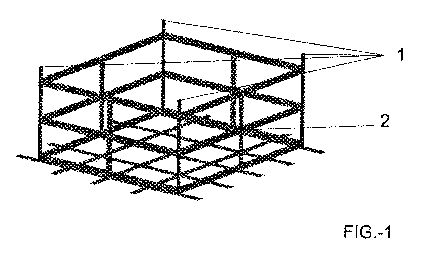
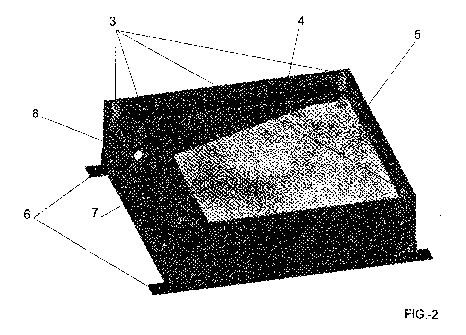
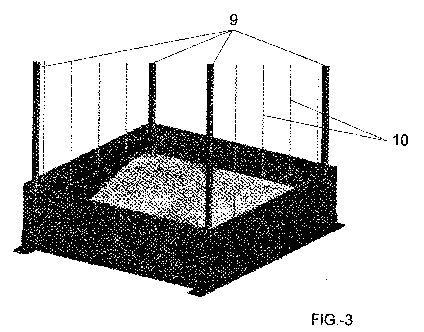
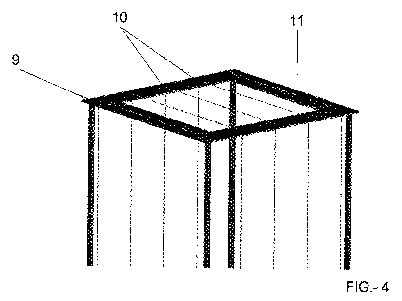
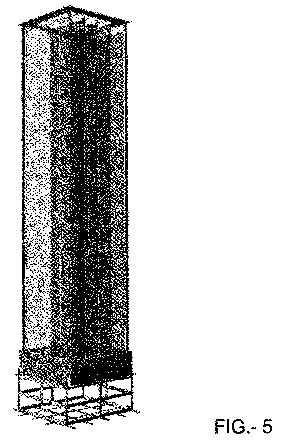
Preferred embodiment mode of the invention
As described in the figures, it is shown how the sensor is constituted of:
- A shoe on the placement of equipment grounding Figure 1, consisting of a structure made of galvanized iron plates, (2), as a cage with four threaded rods welded at the ends, (1) to the union with spare anchor the computer base.
- A square base, according to Figure 2, of 0.7 m. side and 0.2 m high, preferably with four sockets of 20 cm. in length and 25 mm in diameter, for the sustenance of the vertical structures at the corners, (3), two shelves on two sides, (4), 5 cm. the upper edge of the base, to secure these caps and in which some rings that secure the cable frames are placed curtains.
Also it has the inclined bottom, (5), for the collection and decanting of the water obtained, anchoring pieces (binding or shoe heels) punched and welded at the corners on the outside (6), an outlet for overflow 6 cm from the bottom (7) of 25 mm diameter in which a small metal filter, through the interior, and a universal hose connector is placed and finally, an auxiliary output on one side, (8) with a stopcock, to facilitate the cleanup of the team. newpage
- The vertical structures, according to Figure 3, consisting of:. First, four tubes of galvanized iron 20 mm in diameter and a maximum length of 2 m, preferably, (9), which join the base embutiéndolos caps it, serving as support to the outer layer of plastic mesh and the second metallic mesh layer and on the other hand, the frames carried by braided steel cable (10) anchored to the base and the top piece or crown by small carabiners.
About this internal structure layers were fixed insect screen like a curtain.
- The upper part or crown (11), according to Figure 4, is a square frame with a hollow core and multiple perforations.
It serves to give consistency, allowing entry to the rain and keep the prism of the team.
Vertical tubes (9) are joined to this piece with nuts, because they have a small screw welded at its upper end.
The central space is covered with plastic mesh to keep out leaves and other items carried by the wind.
- All scavenging meshes bind to their corresponding structures (pipes or cables) through plastic cable ties.
Applications and uses
- Water supply in remote areas or expensive supplies.
- Supply of agricultural farms of mediocrities.
- Supply tanks or cisterns of forestry and fire trucks normally filled by Cuba.
- Use of preventing and fighting forest fires, reforestation and environmental monitoring.
- Improving by mixing low quality water from another source Industrial (underground, etc.
)
- Supply of forest recreation areas and sources of walkers (on purification).
- Human supply, housing or quarters of tools (on purification). vskip 1.000000 ester
Advantage
- Especially suitable in conditions of moderate to high winds.
- Obtaining high quality water height (height between 800-1500 meters, in the Canary Islands).
- Drives gravity (energy saving).
- No energy consumption and waste generation.
- Easy assembly and installation (savings in storage, transportation and installation).
- Very low maintenance (cleaning and replacement occasionally mesh).
- Supply in situ (saving water transport and pipelines).
- Fully renewable materials.
- Mobile facilities, leaving no residue or shoes on location.
- Exploitation of dew and precipitation without taking up space on the ground.
- Decanting and filtering water obtained integrated.
- Major pickup surface in less space.
- It occupies only 0.5 m2 of land with respect to other sensors that take between 3 and 18 m2, with a volume of water collected similar to these.
- Overlapping inner layers of mesh capture increasing levels of catch (to possess greater exposed surface pickup) without taking up space on the ground and creating a turbulent wind to the path of charged droplets to traverse the maze sensor.
Individualized inner layers and can easily swap or replaced without dismantling the entire structure (layers as curtains).
Supported by cables, providing flexibility, stability and light weight.
- The anchor base or seat is designed PRG for nothing so much his installation over existing slabs, through wall plugs and for placement on land, in this case using a shoe designs PRG nothing in order to secure the anchor down the sensor without the need for works or pouring concrete, installation easier and cheaper by reducing work times.
The weight of the land is exploited, allowing turn the sensor location can be changed if so desired, still remains at the first settlement.